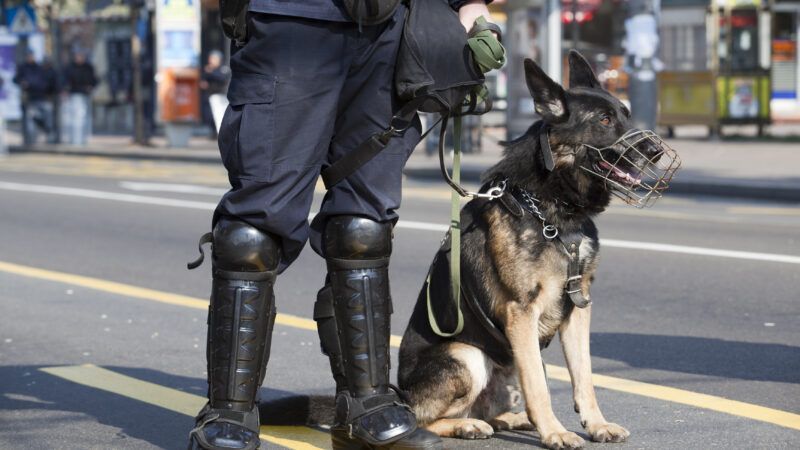California's K9 Reform Bill Is Barking Up the Wrong Tree
Police dogs seriously injured 186 people within the last two years—more than batons or tasers did, according to the ACLU.

A new California bill that forbids police from using canines for crowd control or to apprehend suspects has generated an unusually large amount of attention given its likely slim possibilities of passage. But it strikes me as a case study about why the Legislature so rarely accomplishes anything of substance.
"The use of police canines has been a mainstay in the constant dehumanizing, cruel abuse of Black Americans and people of color," according to the bill. "(P)olice canines are a carryover from a dark past." That's undoubtedly true, but instead of dealing with an ongoing problem in a targeted way, the bill's authors seem intent on making a broader ideological point.
That's given opponents of Assembly Bill 742 (by Assembly members Corey Jackson, D-Riverside, and Ash Kalra, D-San Jose) the opportunity to portray the measure as typical Capitol lunacy. Depicting the bill as "the latest woke hysteria," conservative writer Rob Smith argued in a column that "the reality is that DOGS—no matter what Leftist activists will try to make you believe—CANNOT be racist."
More rationally, Fresno Police Chief Paco Balderrama argued that, "strong accountability already exists in most law enforcement agencies that do not allow for the use of K9s in low-level arrests, non-violent arrests, or for crowd control." That rebuttal focuses on the real question: Are police agencies using their dogs in a responsible manner? In 2020, the Police Executive Research Forum released a detailed report offering guidance for canine units.
In 2013, I reported on a court case involving Sacramento police who were chasing a suspect who hid in a tree in an innocent family's backyard and released the dog. As I wrote, "Police dogs are trained to bite and hold suspects, but they can't distinguish between law-abiding citizens relaxing with friends and police suspects. So Bandit attacked the first person it saw."
Instead of instituting reforms, the department argued that "'officer safety' would be endangered by requiring a reasonable warning before releasing a police dog on private property." Balderrama is no doubt correct that Fresno police dogs have a bite ratio of less than half of one percent, but the Sacramento incident doesn't instill confidence.
The bill's sponsor, ACLU California Action, notes, "police dogs seriously injured 186 people within the last two years—more than batons or tasers. Many of these injuries were accidental and some resulted in death or permanent disfigurement." That's a significant enough problem to warrant a bill that carefully limits procedures for deploying dogs.
Last year, the city of Sacramento paid a $175,000 settlement to a family because of a 2019 incident in which a dog attacked a man in his home, causing him neurological damage. Police knocked on the family's door asking to search their backyard for a fleeing suspect. A family member gave officers access to the yard through the garage, according to the Sacramento Bee.
But an officer "allowed his police K9 to enter the house without permission or warning," and then bit a man sitting at his computer. Dogs aren't racist, as Smith concluded, but they can inflict harm if used improperly. This issue isn't primarily about race, but proper police procedures.
Instead of a broad ban and incendiary language, the legislation should impose strict restrictions on the use of canines—and expand the liability of departments that might disregard the public's safety. Dogs can, as the Fresno chief added, "de-escalate most use-of-force incidents," but these incidents show they can also turn routine encounters into dangerous ones.
Unfortunately, AB 742 doesn't even address one of the main problems with the police use of dogs. As the bill language explains, "This section shall not be interpreted as to prevent the use of police canines by law enforcement for purposes of search and rescue, explosives detection, and narcotics detection that do not involve biting."
Dogs certainly are useful for search and rescue operations and explosives detection, so those exemptions are important. But dogs have a sketchy history when it comes to drug detection. There's a reason police canines are known as "barking probable cause." Their sniffs give officers carte blanche to search people for drugs, yet studies suggest their drug sniffing is inaccurate 50 percent to 75 percent of the time. Why not just flip a coin instead?
Reason magazine reported in 2018 on a Washington state police canine named Karma who "gave an 'alert' indicating the presence of drugs 100 percent of the time during roadside sniffs outside vehicles." Often, police use these highly inaccurate alerts to confiscate people's cars and cash under civil asset-forfeiture laws that allow property takings without due process or securing a conviction for any crime.
So the issue of police dogs is a legitimate one, but if Jackson and Kalra want to be taken seriously they need to focus on the real problems and not just use the legislation as an opportunity to posture.
This column was first published in The Orange County Register.


Show Comments (33)